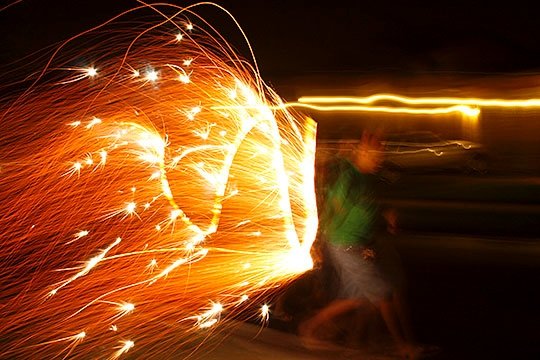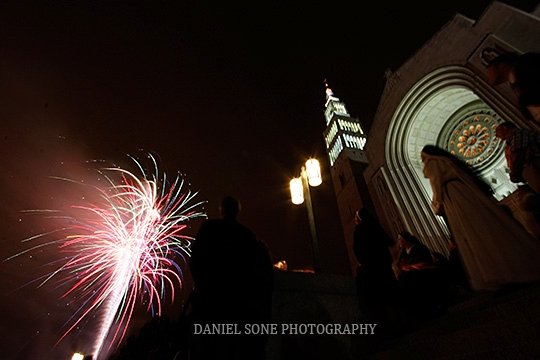Photographing fireworks can be a beautiful and challenging experience. There are a lot of ways to do it, but the most dramatic and pretty shots come from long exposures.
To do a long exposure of fireworks while not blowing-out the flares, I crank my ISO way down to 100 and close down my aperture to about f11. The sweet spot for a burst or two is between 2 and 6 seconds. You can do 10 seconds, but then you may need to go to f22 or f32 to compensate. A lot of cameras have a “Bulb” (B) setting to allow for exposures as long as the shutter button is depressed. I’ve not needed it for fireworks, yet.
A quick n’ dirty method to metering in fireworks is to aim at a light source, like the sun, a street light, or well-lit monument and going about -2/3 stop on it. That should put you in a very close ball park for your fireworks. I use spot metering on these “hotspots” so that the camera ignores all the darkness in the frame. Take a test shot of that first burst and adjust accordingly.
As the show progresses, smoke will haze up the sky, acting like a diffuser. You’ll start to lose detail in the burst trails. You may need to stop-down a little to knock-down the diffusion effect. Or you can keep it and have a bright cloud with colorful sparks emanating from it. It’s up to you.
If you want to put multiple bursts into a shot, there are two methods:
- use a black card to cover the lens between bursts.
- a composite in photoshop.
The black card is challenging because it is a lot like dodging and burning in the darkroom of film days if you’re trying to expose only a part of the frame, jiggling the card to keep buildings and such from blowing out. Also, your camera’s sensor can heat up over time introducing more and more noise into your image. But it makes some cool ass photos. Practice this technique by having a friend or sibling wave around a sparkler, glow stick, or something in one part of the frame as you dodge the other side.
The second method is a little easier, but requires that you keep the same position, settings, and focal length for most ease. Take a frame without any fireworks bursts in it as your “base”. Then in layers and masks, add your desired bursts into the image. Adding later bursts can be challenging because of the haze from the smoke, but setting your fireworks layers to “lighten” or “screen” should help mediate that a little.
The fireworks are great fun and beautiful, but don’t forget the crowd’s reaction to them. I try to use the ambient light from the bursts as my lighting. However, the darkness between bursts can prevent your AF from working and make manual focusing very difficult. To get around this, I pop on my external flash and block the light, using only the AF-assist beam. The AF-assist beam pumps out an infrared beam giving the AF system enough light and contrast to lock onto your subject. So, you can prefocus in the darkness and wait for the maximum illumination for your shot. You may need to crank the ISO way up to handhold and freeze the action, but it will be a nice photo.
Also, including people’s silhouette, a building, or landmark it helps “ground” the photo. Providing a context to your photo helps give it more power than just capturing the bursts against a black sky. Not to say that it won’t be cool or beautiful, but a photograph with context has a very important layer that others usually don’t.
In any case, get out there and have fun whenever fireworks are around!


